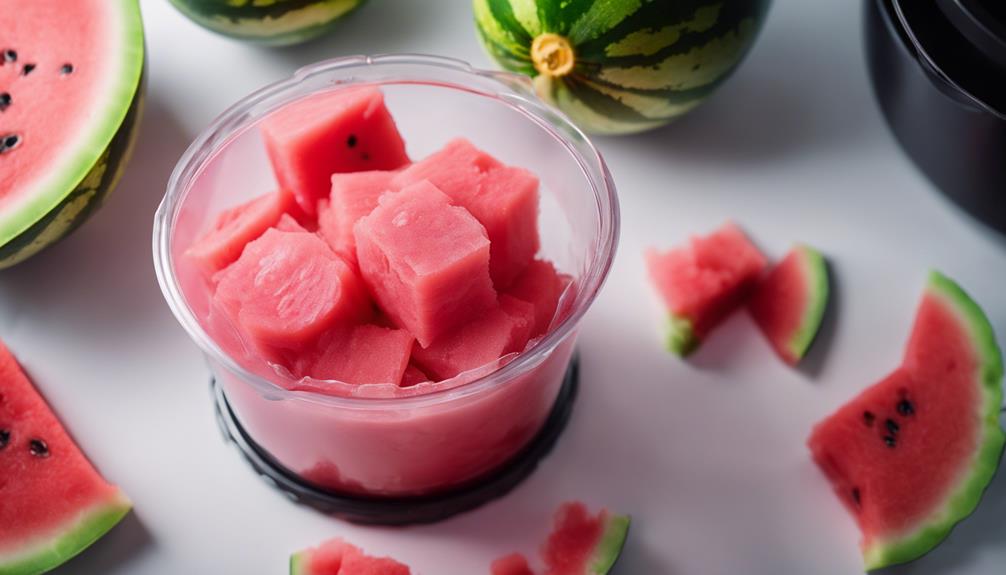Sous Vide Watermelon Sorbet
Immerse ripe watermelon in a sous vide bath to reveal vibrant flavors for your sorbet. Elevate the sweetness with lime juice and fresh mint. Experiment with textures by adjusting churning techniques. Consider coconut cream for a creamy consistency or avocado for a smooth finish. The sorbet's final quality depends on these choices. Dive deeper into sorbet variations like Watermelon Mint Sorbet. Infuse your dessert with creativity using these simple tips.
What You Will Learn Here
- Sous Vide Watermelon Sorbet offers a unique, smooth texture.
- Experiment with ingredients like mint, lime, or coconut cream.
- Churning techniques impact sorbet consistency and quality.
- Ripe, juicy watermelon enhances flavor.
- Enjoy the simplicity and versatility of making this refreshing dessert.
Watermelon's Origin Story

Watermelon's story stretches back to ancient times, tracing its roots through history. The evolution of watermelon showcases its journey from a wild fruit to the juicy summer staple we're familiar with today.
Explore the culinary versatility of watermelon, a fruit that can be enjoyed in a variety of dishes beyond the traditional slices.
Watermelon's Ancient Roots
With origins tracing back to ancient Africa and Egypt, the beloved fruit known as watermelon has a rich history that predates modern times. Watermelon cultivation dates back thousands of years, with evidence suggesting its presence in the Nile Valley. This invigorating fruit wasn't only enjoyed for its sweet taste but also valued for its nutritional benefits. Watermelons were cultivated for their hydrating properties, as they're made up of over 90% water, making them a perfect snack in hot climates.
In ancient times, watermelons weren't only consumed for their delicious flesh but also for their seeds, which were roasted for a crunchy snack. Rich in vitamins A and C, as well as antioxidants like lycopene, watermelon offered both hydration and essential nutrients to those who enjoyed it.
Throughout history, watermelon has traveled across continents, evolving into the juicy, vibrant fruit we recognize today. Its ancient roots reveal a fruit that hasn't only delighted taste buds but also nourished bodies for generations.
Evolution of Watermelon
Tracing back through centuries, the evolution of watermelon reveals a fascinating journey of transformation and adaptation. Watermelon, with its origins in Africa, has undergone significant genetic changes over time through cultivation.
In ancient history, watermelon held great significance, featuring prominently in folklore and traditions. The fruit's evolution has led to the development of diverse flavors and recipes that showcase its versatility. From sweet to savory, watermelon can be presented in various ways, enhancing its appeal through different pairing techniques.
The consistency of watermelon, whether in salads, drinks, or desserts, can be manipulated through temperature and preparation methods, offering a range of textures to satisfy different preferences. Understanding the evolution of watermelon provides insight into how this fruit has adapted to suit changing tastes and culinary practices.
Exploring the historical journey of watermelon not only enriches your knowledge but also deepens your appreciation for this invigorating and versatile fruit.
Culinary Versatility of Watermelon
Frequently celebrated for its culinary versatility, watermelon's origin story reveals a rich tapestry of flavors and traditions. Believed to have originated in Africa, watermelon quickly spread across the globe, becoming a beloved fruit in various cuisines. Its juicy sweetness lends itself well to a wide array of culinary techniques, making it a versatile ingredient in both sweet and savory dishes.
In the world of culinary techniques, watermelon can be grilled to enhance its natural sweetness or blended into invigorating beverages like agua fresca. Its mild flavor pairs beautifully with tangy feta cheese in salads, while mint and lime create a zesty contrast in watermelon-based salsas. The fruit's ability to take on different flavor profiles makes it a favorite for creative chefs looking to experiment with unique combinations.
Whether you're exploring traditional recipes or inventing new flavor pairings, watermelon's culinary adaptability continues to captivate taste buds around the world.
Watermelon's Essential Sorbet Components
To create an invigorating watermelon sorbet, you'll need to focus on the essential components of the fruit. Consider the following:
- Fresh Watermelon: Choose a ripe, juicy watermelon for the best flavor and sweetness.
- Lime Juice: Adding a splash of fresh lime juice enhances the watermelon's natural tanginess.
- Simple Syrup: A mixture of water and sugar boiled together to add sweetness and texture to the sorbet.
- Mint Leaves: Fresh mint leaves can elevate the sorbet with a hint of herbal freshness.
Watermelon Sorbet Creations

When it comes to watermelon sorbet creations, you have a variety of delectable options to choose from.
Try making a Chilled Watermelon Mint Sorbet for a cool treat on a hot day.
Or experiment with a Watermelon Basil Sorbet for a unique twist on a classic dessert.
Lastly, consider a Tangy Watermelon Sorbet for a zesty and flavorful experience.
Chilled Watermelon Mint Sorbet
For an invigorating twist on traditional watermelon sorbet, try adding fresh mint leaves to create a Chilled Watermelon Mint Sorbet. This delightful combination offers a revitalizing burst of flavors that will tantalize your taste buds.
Here are some tips to enhance your experience:
- Flavor Explosion: The sweet and juicy watermelon pairs perfectly with the cool, peppermint undertones, creating a harmonious blend of flavors.
- Textural Delight: The smoothness of the sorbet combined with the subtle crunch of chopped mint leaves provides a delightful textural contrast in every bite.
- Serving Elegance: Present your Chilled Watermelon Mint Sorbet in chilled glass bowls garnished with a sprig of fresh mint for a visually appealing and appetizing treat.
- Cooling Perfection: To elevate the cooling sensation, serve the sorbet in frozen watermelon rinds or chilled dessert glasses.
Indulge in the cool, minty goodness of this Chilled Watermelon Mint Sorbet for a delightful and invigorating dessert experience.
Watermelon Basil Sorbet
Enhance your sorbet repertoire with the invigorating combination of watermelon and basil in this Watermelon Basil Sorbet creation. This revitalizing treat offers a delightful blend of sweet watermelon and aromatic basil, creating a unique and flavorful experience for your taste buds.
- Flavor combinations:
- The sweetness of the watermelon perfectly complements the herbal notes of the basil, providing a harmonious balance of flavors.
- The basil adds a fresh and earthy undertone to the sorbet, elevating the overall taste profile.
- The combination of watermelon and basil offers a rejuvenating and light dessert option for hot summer days.
- The subtle peppery hints from the basil enhance the sweetness of the watermelon, creating a complex and satisfying flavor profile.
- Serving suggestions:
- Serve the Watermelon Basil Sorbet in chilled bowls for a cool and revitalizing dessert experience.
- Garnish with fresh basil leaves or a sprinkle of lime zest to enhance the visual appeal and add an extra layer of flavor. Enjoy this sorbet on its own or as a palate cleanser between courses for a burst of summer goodness.
Tangy Watermelon Sorbet
Indulge in a zesty delight with this Watermelon Sorbet creation that offers an invigorating twist on traditional sorbet flavors. This revitalizing summer dessert will surprise your taste buds with its unique watermelon pairing, creating a burst of flavor that's both sweet and tangy.
Experience the perfect balance of sweetness and tartness in every spoonful with this Tangy Watermelon Sorbet. Let the vibrant colors of the sorbet remind you of a sunny summer day, bringing a touch of brightness to your dessert table.
Imagine the cool, smooth texture of the sorbet melting in your mouth, leaving behind a subtle watermelon essence.
Picture the contrasting sensations of the icy sorbet against the warm summer air, creating a rejuvenating moment of indulgence.
Visualize the delicate sweetness of the watermelon pairing harmoniously with the tangy notes, creating a symphony of flavors.
Envision yourself savoring each spoonful, feeling the summer vibes with every bite.
Don't miss out on this exciting twist on a classic sorbet; try this Tangy Watermelon Sorbet for a delightful summer treat.
Sorbet Texture Enhancement
When aiming to enhance the texture of your sorbet, consider your texture preferences, the impact of ingredients, and different churning techniques.
Your preferred texture will guide you in adjusting ingredients and techniques to achieve the desired consistency.
Experiment with various combinations to find the perfect balance for a smooth and creamy sorbet.
Texture Preferences
For a smoother sorbet texture, consider incorporating additional fruit puree into the mixture. This won't only enhance the flavor but also contribute to a creamier consistency. Experiment with different fruit combinations to cater to your flavor preferences.
Temperature plays an important role in sorbet texture. Make sure your mixture is properly chilled before freezing to achieve the desired mouthfeel contrasts.
When serving sorbet, presentation matters. Opt for chilled serving bowls or glasses to maintain the sorbet's texture longer. Consider garnishing with fresh mint leaves or a drizzle of honey for added visual appeal. These serving suggestions can elevate the overall experience of enjoying sorbet.
To enhance the mouthfeel of your sorbet, try incorporating small pieces of diced fruit into the mixture before freezing. This will create delightful bursts of flavor and texture with each spoonful. Remember, texture preferences vary, so don't be afraid to experiment to find what suits your palate best.
Ingredient Impact
To enhance the texture of your sorbet, consider experimenting with different ingredients such as coconut cream or avocado to achieve a creamier consistency. When it comes to ingredient pairing, coconut cream can add a luscious richness to the sorbet, while avocado brings a velvety smoothness.
These additions not only alter the texture but also introduce new flavor profiles to your watermelon sorbet. Coconut cream provides a tropical undertone, complementing the sweetness of the watermelon, while avocado adds a subtle creaminess without overpowering the fruity essence.
Churning Techniques
Consider incorporating different churning techniques to enhance the texture of your watermelon sorbet, ensuring a smoother consistency and a more satisfying mouthfeel. Churning plays an essential role in sorbet-making, impacting both the final texture and overall quality of the dessert. By varying the churning speed and method, you can create a sorbet that's velvety and luxurious.
Flavor infusion is maximized through churning, as the process helps distribute the watermelon puree evenly, ensuring a balanced taste experience in every scoop. Additionally, the incorporation of air during churning contributes to a lighter and creamier sorbet texture, making it more enjoyable to eat.
Temperature control is key during churning to prevent the sorbet from becoming icy or grainy. Keeping the mixture at the right temperature while churning allows for the formation of small ice crystals, resulting in a smoother sorbet consistency. Experiment with different churning techniques to find the perfect balance of creaminess and lightness in your watermelon sorbet.
Final Thoughts

As you reflect on your experience making this Sous Vide Watermelon Sorbet, keep in mind the versatility of this invigorating dessert.
When considering your reflections, think about the ease of the sous vide method in extracting the pure essence of watermelon for a revitalizing sorbet.
The simplicity of the process allows for various recipe variations to suit your taste preferences.
You might want to experiment with adding a hint of mint for a subtle twist, or perhaps a splash of lime juice to enhance the fruity flavors further.
Frequently Asked Questions
Can I Use Frozen Watermelon for This Sorbet Recipe?
Yes, you can use frozen watermelon for the sorbet recipe. It will enhance the flavor and provide a smoother texture. Experiment with different frozen fruits for unique flavor variations and adjust texture preferences by adding more liquid if needed.
Is It Necessary to Strain the Watermelon Puree Before Freezing?
You should strain the watermelon puree before freezing for a smoother sorbet. Straining is important for achieving a velvety consistency if your texture preferences lean towards a more refined sorbet, as it helps in removing excess fibers and seeds, enhancing texture.
Can I Add Other Fruits to the Watermelon Sorbet Mixture?
You can definitely add other fruits to your watermelon sorbet for fun fruit combinations and flavor experimentation. Adjusting the mixture can also help you achieve your preferred texture and consider using sugar alternatives for a healthier option.
How Long Can I Store Watermelon Sorbet in the Freezer?
You can store watermelon sorbet in the freezer for up to three months without sacrificing flavor. Experiment with different fruits for unique flavors. Serve it with fresh mint or a splash of lime juice for a invigorating twist.
Can I Use a Different Sweetener Other Than Sugar for This Sorbet?
You can definitely experiment with alternative sweeteners for your sorbet. Options like honey, agave, or stevia can work well. Get creative with flavor combinations by adding mint, lime, or even chili for a unique twist.
Conclusion
To sum up, sous vide watermelon sorbet offers a revitalizing and delightful treat that captures the essence of summer.
By utilizing precise temperature control and sealing in the flavors, this method guarantees a smooth and creamy texture that enhances the natural sweetness of the fruit.
Experiment with different variations and additions to create your own unique watermelon sorbet creations.
Enjoy this simple yet elegant dessert that's sure to please your taste buds.











